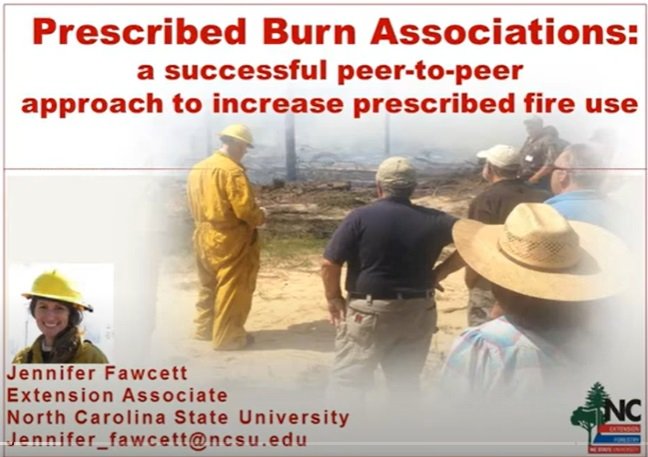Happy December, FACNM Community!
With winter upon us, the season for pile burning, a type of prescribed burning, has begun. Prescribed burning (also called controlled burning or controlled fire) is an incredibly important tool used across the country to promote healthier forests and reduce the risks of wildfire. It also features prominently as a treatment in many landscape-scale projects. While you may think of prescribed burns as something done only by federal employees wearing yellow nomex shirts and hardhats, this tool is actually utilized a diverse array of organizations and individuals concerned with the health of their surrounding ecosystems. Today we will discuss Prescribed Burn Associations, an integral part of putting this tool into the hands of landowners and communities.
Today’s Wildfire Wednesday features:
Best,
Dayl
Learn more about Prescribed Burn Associations!
What is a Prescribed Burn Association?
This Prescribed Burn Association Interactive Map from the Great Plains Fire Science Exchange shows active PBAs across the U.S.
A Prescribed Burn Association (PBA) is a group of landowners and other interested people from a specific geographic area that form a partnership to help one another conduct prescribed burns. The first PBAs, also referred to as prescribed burn cooperatives, were formed in Nebraska around 1995, Texas in 1997, and Oklahoma in 2001 to overcome the constraints limiting the use of prescribed fire on rangelands.
These associations are community-built efforts in which members combine their knowledge, equipment, and other resources to provide learning opportunities and reduce barriers with the end goal of implementing more prescribed burns as private landowners. Common barriers include personal and professional liability associated with fire use, lack of training, lack of equipment, and lack of resources. It can be very difficult for private landowners to gain the hands-on training needed to safely and effectively use prescribed fire, and PBAs can provide that training while building a network of engaged landowners who can connect on an array of land management concerns.
In the broader context of land management, PBAs can also help fill the gaps in capacity that result from overburdened agencies with a backlog of millions of acres to burn. Because PBAs can operate with much less overhead and formality than agency-implemented burns, they are more agile and flexible in their pathways to implementing prescribed burns in their communities.
As a coalition of neighbors, friends, and locals, PBAs can build trust, improve attitudes toward fire, and increase the social acceptability of using prescribed fire as a management tool. In south-central North Carolina, the Sandhills PBA offers one example of how quickly attitudes can change:
As part of the initial community gathering rolling out the Sandhills PBA, attendees were surveyed before and after the meeting. Beforehand, 34% of the attendees planned to join the PBA and 16% said they would not join. After the meeting, 56% of attendees had decided to join and 0% remained opposed! Read more about this success story here.
For more information about prescribed burn associations, this FAC Learning network webinar recording discusses PBAs and is part of a webinar series about different wildfire resilience programs around the country. Learn about Fire Councils and Training Exchange Programs as part of the series!
Learn more about the NM Prescribed Fire Council!
NM Prescribed Fire Council
New Mexico has what is called a Prescribed Fire Council (PFC). These councils are generally statewide organizations that often work in tandem and share many common goals with localized prescribed burn associations. PFCs allow private landowners, fire practitioners, agencies, non-governmental organizations, policymakers, regulators, and others to exchange information related to prescribed fire and promote public understanding of the importance and benefits of fire use.
A map showing which states have Prescribed Fire Councils, from the Coalition of Prescribed Fire Councils, Inc.
PFCs date back to 1975, when the first council in the US was created in Florida in response to rapid development in Miami. Shortly thereafter, the North Florida Prescribed Fire Council was created in 1989 and more explicitly focused on prescribed fire. Neighboring states observed the success of Florida’s programs and began adopting the council model to incorporate federal, state, and private interests. Eventually, prescribed fire councils started to spread beyond the Southeast and across the country. Today, most states have established councils.
For those who want to get involved in New Mexico, membership in the New Mexico Prescribed Fire Council is open to anyone who has a passion for utilizing beneficial fire as a land management tool. Visit the website to become a member or to learn more about the resources provided by the council.
For more information about prescribed fire councils, view this FAC Learning Network webinar recording for a brief overview!
Learn more about the training course!
NM State Forestry’s Prescribed Fire Training Course
New Mexico EMNRD Forestry Division (‘State Forestry’) launched a free publicly available prescribed burning curriculum in autumn 2023. This training, required by the passage of the 2021 Prescribed Burning Act, is accessed through their website. Both primary training and certification waivers are offered through their Canvas portal, where interested individuals can create a free account using the code provided on the Forestry Division - Prescribed Burning webpage. You can choose to sign up for pile burning or broadcast burning courses and progress through the interactive modules which cover topics such as safety, public relations, fire behavior, techniques, etc. Learn more about the Act, and the Curriculum available to landowners and individuals interested in learning how to conduct prescribed burns in a safe manner, by attending the FACNM webinar on Supporting Prescribed Fire in New Mexico on 12/7/23 from 2-3pm.
The dashboard for the learning portal.
Learn more about upcoming events and announcements!
Upcoming Webinars & Prescribed Fire in the News
Webinars
Webinar: Supporting Prescribed Fire in New Mexico
Thursday, December 7th
Join FACNM as we discuss New Mexico's new certified burn program and ways to responsibly and safely increase implementation of prescribed fire across jurisdictions and land boundaries in the state! This presentation is open to practitioners, leaders, and members of the public.
Webinar: Developing Community Wildfire Protection Plans in Your Community
14 December, 2023 / 10 January, 2024 at 12:00pm
Learn what a Community Wildfire Protection Plan (CWPP) is, including: why your community may need one, what the process involves, what the components are, what resources you need to complete one, how to use CWPPs to support funding for implementation, and more! Join the webinar to hear about how CWPPs are increasingly being used to direct various funding opportunities, including Community Wildfire Defense Grants (CWDG). This program will also be offered en español.
In the News
NM Fire Info - Pile Burning Projects Planned Across Carson National Forest
With the arrival of winter weather, Carson National Forest fire crews are preparing to continue prescribed fire activities, this time in the form of pile burning. Thinning and prescribed fire are two of the most important tools of the Wildfire Crisis Strategy to promote healthier forests and reduce the risks of wildfire. Planned pile burning in the Carson National Forest this winter will contribute to major landscape projects across the forest. National Forests across the state, including the Carson, have incorporated the findings and recommendations of the summer 2022 prescribed burning pause and resulting National Prescribed Fire Program Review to ensure that prescribed fires follow more rigorous standards, have more impactful checks and balances, and prioritize the safety of firefighters and communities.
Thinning and prescribed fire are two of the most important tools of the Wildfire Crisis Strategy to promote healthier forests and reduce the risks of wildfire. Planned pile burning in the Carson National Forest this winter will contribute to major landscape projects across the forest.
NPR All Things Considered Radio Story - This Year Saw More Prescribed Fire Than Ever Before
Listen to this recent story from a prescribed burn in El Rito, which paints the picture of a broadcast burn and much of what it entails. It also provides the unique historical and social context of prescribed fire in northern New Mexico—a teeter-totter where on one side we have communities understandably opposed to prescribed fire given the tragic events of last year, and on the other side the dire need for fuels reduction to avoid catastrophic wildfires in the future. The two are inextricably linked, and fire practitioners must find the balance.
HEPA Filter Loan Programs
Portable HEPA air filters provide clean and healthy breathable air to individuals and households by filtering out very small and harmful particles, such as those carried in wildfire smoke, allergens, and industrial smog. FACNM offers a HEPA filter loan program, with several participating areas across north and central New Mexico. These are prioritized for loan to smoke-sensitive individuals during periods of smoke impacts and are shared in coordination with network partners, such as the Carson National Forest. A November 24 article from NPR linked in the section above detailed the importance of a HEPA filter loan program in building public trust, saying “today [Angie Krall, El Rito District Ranger, will] stop by a community library and lend an air filter to someone with asthma.”
Smoke from wildfires and prescribed fires is a serious concern as it can cause or exacerbate health conditions for some people living in fire-adapted communities. The Carson National Forest - El Rito Ranger District is part of this program, and folks in that area can reserve filters directly with them by calling (575) 581-4554.










